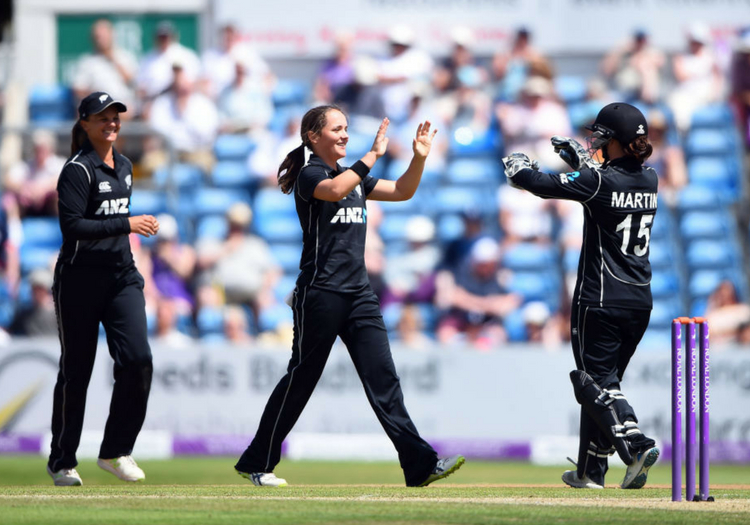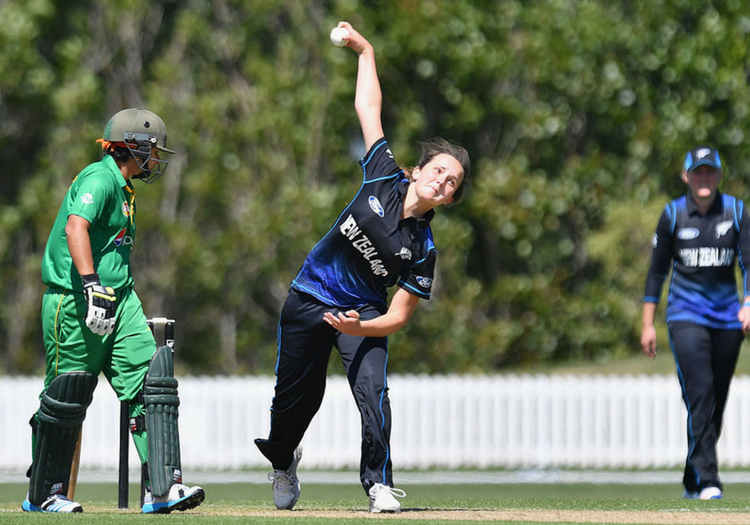JAMES COYNE: It is not so surprising to see 17-year-old Amelia Kerr thrash a women’s ODI-record score of 232 not out against Ireland, and looking so assured bowling at England or in the Kia Super League


Amelia Kerr is one of the bright young things of women's cricket
Aged 14, Amelia Kerr was picked by Wellington for the T20 domestic final against Otago – shown live on Sky TV in New Zealand.
Almost every ball of her four-over spell was on the spot; she took her wickets bowled, stumped and lbw; Suzie Bates was dropped off her at long off. She bowled the googly and the toppie.
Knowing that, it is not so surprising to see 17-year-old Kerr thrash a women’s ODI-record score of 232 not out against Ireland, and looking so assured bowling at England or in the Kia Super League.
“I’m quite a relaxed kind of person,” Kerr told The Cricketer. “People vary, don’t they? Personally I don’t feel too many nerves. My family are quite chilled about stuff. It’s come from that, I think.”
Family has been fundamental in Kerr’s rise. It is the way of women’s cricket – and it will truly be a sign of progress when girls find their way to the top without emerging from a cricketing family. Kerr’s father, Robbie, played for Wellington in the mid-’90s, and Amelia followed mum Jo and sister Jess into the women’s team.

Kerr holds the record for the highest ODI score for women
Her grandfather, Bruce Murray, played 13 Tests as a suitably quirky Kiwi cricketer. He was a Christian who preferred not to play on Sundays, and is one of the few Test bowlers with an average of 0.00, having dismissed Abid Ali at the Basin Reserve in 1967/68.
Apparently in one Test at Dacca, after being pelted with fruit, Murray caught a banana and sprinted towards the middle; Dayle Hadlee ran in and bowled, Asif Iqbal cut, and Murray caught the ball one-handed, diving forward, with the banana still in his hand. It was ruled dead ball.
“I saw what professional cricket could do to you as a person,” wrote Murray. “You became much more self-centred, much more inward-looking, too concerned about the wrong parts of the game, watching the averages. Not so team-oriented. It isn’t sport. It hardens people, makes them selfish and narrows their view of the world.”
Any lesson in that for Kerr? She says her granddad has stayed at arm’s length when it comes to her cricket: “Nah, he hasn’t had any kind of role at all! He’s just my granddad and a good family man. He’s super-smart, a walking Google. And the way he is as a person is an important lesson for me: if cricket is just my life then I might not be happy. You do get down as a cricketer, and it can be a lonely place, so you need other things in life.”
There are a few female leggies coming through now: India have Poonam Yadav, and Amanda-Jade Wellington and Kristen Beams are in the Australia team.
Kerr says: “I started messing around bowling spin in the back garden, aged 10. Dad said it was actually quite good. Luckily he got me working with a leg-spin coach in Wellington, Ivan Tissera. I would not be where I am now without him. I also did a bit of work with Pete Younghusband, who knows all the variations.
“The weather in England has been great for me. I feel in the game when it’s turning.”
It has been a long time away from home for Kerr. Against Ireland in June, she scored 81, then the double-hundred that broke Belinda Clark’s record, made three years before Kerr was born.
Sensibly, she is keeping an eye on her studies: she wants to do well enough in her exams next year that she has the option of going to university – and she wants to teach, like her grandad.
“I was pretty busy with school work before I came away on this tour. I was doing my interval exams, and I have a few assignments to do while I’m away, but it’s all under control.”

Kerr is just 17 years old
All things being equal, Kerr would head on from the KSL to the World T20 to the Big Bash. But she recognises the need to concentrate on her studies – not to mention just enjoying growing up.
“The BBL is something I’d like to do soon. There would be lots of flights – but it’s closer to home. Definitely I will do it, but this season I’m not sure. It would be a long time away in total, and it’s important to ensure that I enjoy time to myself and enjoy life. Balance is quite important to me.
“I’m playing the whole KSL so it will still be three and a half months away from home. But I’m still very much enjoying it. Luckily I don’t get too homesick, but I do miss my family and friends a little bit.”
Not so long ago, teaching was the fallback for many a woman cricketer. But professionalism is coming, to a degree that Murray would not have foreseen.
Though one of the traditional ‘Big Four’ women’s nations, New Zealand lack England, Australia and India’s financial muscle. The likes of Bates, Sophie Devine and Lea Tahuhu have professional contracts, but top up their salary by playing in the KSL and BBL. A new pay deal for New Zealand players is pending.
“Definitely in the future I’d like to be a professional cricketer,” says Kerr. “Half the New Zealand team are pro; the other half are semi-pro. It’s not quite enough on its own yet just to be a pro through the White Ferns. But it’s getting better all the time – there used to be just 10 contracted players and now there are 15.”
The summer issue of The Cricketer is available now at all good newsagents